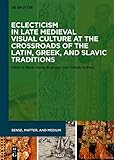Eclecticism in Late Medieval Visual Culture at the Crossroads of the Latin, Greek, and Slavic Traditions / ed. by Maria Alessia Rossi, Alice Isabella Sullivan.
Material type: TextSeries: Sense, Matter, and Medium : New Approaches to Medieval Literary and Material Culture ; 6Publisher: Berlin ; Boston : De Gruyter, [2021]Copyright date: ©2022Description: 1 online resource (XVIII, 434 p.)Content type:
TextSeries: Sense, Matter, and Medium : New Approaches to Medieval Literary and Material Culture ; 6Publisher: Berlin ; Boston : De Gruyter, [2021]Copyright date: ©2022Description: 1 online resource (XVIII, 434 p.)Content type: - 9783110693164
- 9783110695632
- 9783110695618
- N5975 .E25 2022
- online - DeGruyter
- Issued also in print.
| Item type | Current library | Call number | URL | Status | Notes | Barcode | |
|---|---|---|---|---|---|---|---|
 eBook
eBook
|
Biblioteca "Angelicum" Pont. Univ. S.Tommaso d'Aquino Nuvola online | online - DeGruyter (Browse shelf(Opens below)) | Online access | Not for loan (Accesso limitato) | Accesso per gli utenti autorizzati / Access for authorized users | (dgr)9783110695618 |
Frontmatter -- Contents -- Acknowledgements -- List of Contributors -- List of Illustrations -- Foreword -- Introduction -- Negotiating Traditions -- 1 Cross-Cultural and Transcultural Entanglement and Visual Culture in Eastern Europe, ca. 1300–1550 -- 2 Serbian Royal Mausolea:A Quest for Cultural Identity -- 3 Byzantine Forms and Catholic Patrons in Late Medieval Transylvania -- 4 Buttressing Orthodoxy: Imagining Hagia Sophia and Celebrating Constantinople in Sixteenth-Century Russia -- 5 Eclecticism and Originality in the Early Post-Byzantine Art of the Ottoman Balkans -- Shifting Iconographies -- 6 Pro or Contra Filioque? Trinitarian Synthronoi Images at the Crossroads of the Catholic West and the Orthodox East (ca. 1300–1500) -- 7 The Dormition of the Virgin Between East and West: Artistic Exchange and Innovation in Medieval Wall Paintings from Slovakia -- 8 The “Hybrid” Iconography of the Agnus Dei in Moldavian Wall Paintings -- 9 The Akathistos on the Move and the Geography of Post-Byzantine Art -- 10 The Crucified Monk at the Edge of Traditions -- Patterns of Patronage -- 11 “Sic enim Constantinus . . .” The Equestrian Portrait of King Ladislaus Jagiełło in the Holy Trinity Chapel at the Castle of Lublin (1418) -- 12 Donors, Patrons, and Benefactors in Medieval Epirus Between the Great Empires: A Society in Change or Continuity? -- 13 Albanian Votive Images as Media of Transcultural Interaction Between Tradition and Innovation -- 14 Toward a New Era: Patronage and Luxury Endowments to Mount Athos (Fourteenth to Mid-Sixteenth Centuries) -- 15 A Murderer Among the Seraphim: Lăpușneanu’s Transfiguration Embroideries -- Indexes
restricted access online access with authorization star
http://purl.org/coar/access_right/c_16ec
This volume builds upon the new worldwide interest in the global Middle Ages. It investigates the prismatic heritage and eclectic artistic production of Eastern Europe between the fourteenth and seventeenth centuries, while challenging the temporal and geographical parameters of the study of medieval, Byzantine, post-Byzantine, and early-modern art. Contact and interchange between primarily the Latin, Greek, and Slavic cultural spheres resulted in local assimilations of select elements that reshaped the artistic landscapes of regions of the Balkan Peninsula, the Carpathian Mountains, and further north. The specificities of each region, and, in modern times, politics and nationalistic approaches, have reinforced the tendency to treat them separately, preventing scholars from questioning whether the visual output could be considered as an expression of a shared history. The comparative and interdisciplinary framework of this volume provides a holistic view of the visual culture of these regions by addressing issues of transmission and appropriation, as well as notions of cross-cultural contact, while putting on the global map of art history the eclectic artistic production of Eastern Europe.
Issued also in print.
Mode of access: Internet via World Wide Web.
In English.
Description based on online resource; title from PDF title page (publisher's Web site, viewed 25. Jun 2024)


